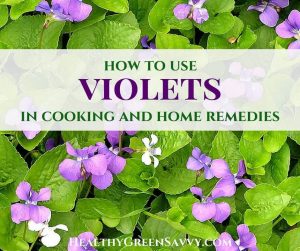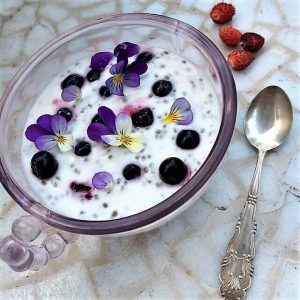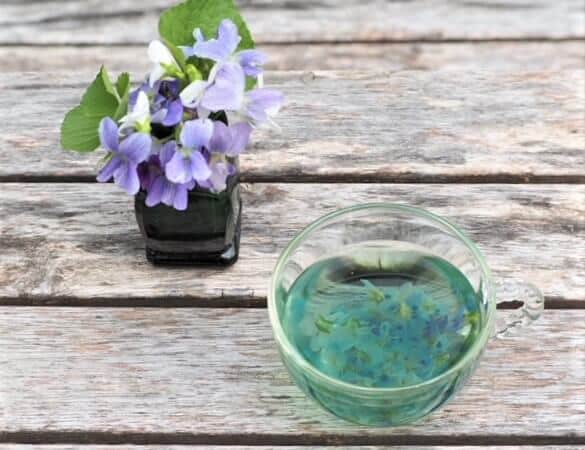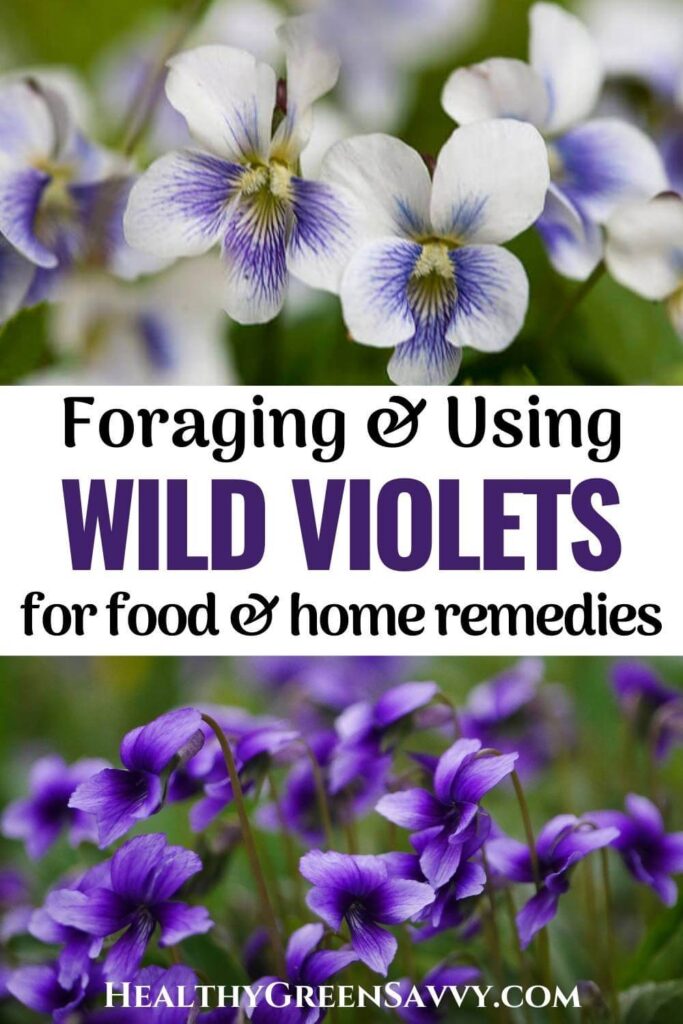Last Updated on May 19, 2025
Do you have wild violets growing in your yard? Besides the fact that violets are edible, there are plenty of other reasons you’ll want to encourage these gorgeous signs of spring. Both the edible leaves and flowers have medicinal uses, plus wild violets make an excellent low-maintenance ground cover.
There are so many reasons to love wild violets. When spring is in full swing, we make sure to pick plenty of the gorgeous wild violets that have colonized our edible yard. These lovely edible flowers aren’t just beautiful, wild violets are full of nutrients to nourish your body!

Are Wild Violets Edible?
Yes, indeed, you can eat wild violets! And not just the pretty violet flowers are edible, the abundant leaves are as well. We use violets’ lovely heart-shaped leaves in salads early in the season and in herbal teas all season long. well after the flowers are gone. Learn about more about uses for violet leaf in a separate post focused solely on them.
Wild violets are one of my favorite edible “weeds,” plants that grow without work from you that can be put to use in your kitchen and home remedies arsenal. Some other favorites include purslane, yarrow, dandelion, chickweed, elderflower, cleavers, and wood sorrel.
I’ve recently discovered Virginia waterleaf, a very early wild green that’s ready for harvest long before the edible wild violets. And once violet leaves have gotten too tough for anything but tea, tender and flavorful strawberry blite shows up, with its prolific sweet berries as a bonus.
You can even use creeping Charlie for food and medicine. Clover is edible, too! There are dozens more wild greens to explore throughout the season.
Catnip is another plant that can turn up in your yard, and it pairs nicely with violets and other herbs like lemon balm in a calming tea with other herbs that help promote sleep. It might already be growing in your garden. Here’s how to distinguish catnip vs catmint if you’re not sure.
I consider these underappreciated plants among the many perennial herbs and perennial vegetables worth growing in the garden.
If you have wild violets in your yard, I think you should consider yourself lucky. Though it seems like a lot of people want to get rid of wild violets from their lawns, I want to make a case for welcoming them into your garden.
Wild violets have some winning attributes as garden plants as well some excellent medicinal uses. Plus they’re beautiful and tasty. And it’s so much fun to eat things most people don’t realize are edible 🙂
Here’s why to encourage edible wild violets in your garden.
Edible Wild Violets in the Garden
Violets make fantastic groundcovers, perfect if you’re trying to eradicate or limit your lawn. They will spread themselves all over and require little more from you than some water during longer dry spells. Unlike grass, they do well in shade.
And no mowing!
As we’ve replaced our lawn with edible and medicinal grass alternatives, wild violets have been the superstars, filling in where everything else I’ve tried to plant has gotten shaded out over the years. We now have a front yard covered mostly in violets that requires basically no maintenance (or weeding), no fertilizing, and very little watering. How’s that for eco-friendly landscaping?
Here are loads more ground cover herbs to consider if you’re looking to replace grass or mulch in your garden.
Though the flowers bloom for a relatively short time, wild violets’ heart-shaped leaves last all season.
And of course, important to those of us who like to grow as much food as we can, you can eat them!
Foraging Edible Wild Violets
Nearly all violets are edible (see exceptions below). European sweet violets (Viola odorata) have more scent and flavor than the common North American variety, Viola odorata, also known as wood violets or common blue violets. The wood violets growing in my yard aren’t particularly flavorful, but they’re so beautiful in salads, who cares? Lucky you if the sweet kind grow near you!
All the different colors of violets — blue, white, purple, mixed — are edible, though yellow violets may “cause gastrointestinal distress” according to my favorite source for foraging wisdom, “Wildman” Steve Brill. Johnny jump ups (viola tricolor) and cousin pansy are also edible.
If you’re newer to foraging, there are many other wild edible plants perfect for beginners.
Use only the edible violet flowers and leaves — the underground rhizomes are poisonous. Always consult a good guide when you’re foraging a plant for the first time.
Here are some of the best foraging books I’ve found.
Consider taking a course on plant identification and uses. The Herbal Academy has an excellent online foraging course that teaches plant identification and ethical wildcrafting practices.
**Note that African violets (Streptocarpus ssp.) are not true violets and shouldn’t be eaten.**
Brill also cautions not to confuse violets with either of the two plants below, which are not edible:
Poisonous dwarf larkspur (Delphinium tricorne) has a similar violet flower, but with a “spur” behind the flower, and a different leaf. Monkshood (Aconitum uncinatum), also poisonous, has a large, helmet-like upper sepal that covers 2 petals.
This post has some other potential look alikes to be aware of.
Always harvest responsibly. Use a guide to correctly identify the plant, and make certain it hasn’t been sprayed. A good rule of thumb is to harvest no more than a third of any given plant. Check the threatened and endangered plant list from the USDA as well — some varieties of violets are on it. (Check the box with your state, then scroll down to the listings under “viola.“)
Edible Wild Violets in the Kitchen
You can eat both the leaves of wild violets and their gorgeous flowers. Both are rich in vitamins A & C, and the leaves are a good source of fiber and all those amazing phytochemicals that help prevent inflammation and keep our bodily systems humming. See ideas for using them below.
Violets were used in all sorts of inventive ways in Europe prior to the twentieth century. If you’re interested in food history, check out this article from the Telegraph.
In addition to being one of the flowers you can let eager kiddos pick at will (and munch on for a snack), violets are a lovely addition to salads and smoothies. Their flavor is mild, and they add color and nutrients.
Younger leaves will be more tender for fresh eating, but you can cook older leaves in soups and stews. Their mucilaginous quality makes them a good thickener. If you have sweet violets, you probably want to use them in sweet rather than savory dishes.
I’m all about simple, so our violets mostly get used for salads and smoothies. That nice hit of just-picked green is a perfect addition to spring salads.
Just rinse and toss some wild violet flowers and leaves into your salad or smoothie. Wild violets would work in place of the purslane in my anti inflammatory smoothie until the purslane season begins.
You can also use violet flowers to top desserts like cakes, homemade ice cream, chia puddings and more. Or just pop them on top of a bowl of homemade yogurt for fun.

Wild Violets Medicinal Uses
- Violets are thought to be useful yet gentle detoxifiers.
- Violets can have a diuretic and laxative effect, so don’t eat them in great quantities. But useful if that’s what you’re after!
- Their high vitamin C content has made wild violets popular for treating and preventing colds.
- Violets are thought to stimulate the lymphatic and immune systems.
- Violets are demulcent, making them one of the soothing herbs for cough and an effective cooling herb
- Violets are also expectorant, making them a useful natural cough remedy, along with common mallow, another plant with mucilaginous qualities.
- Violets may have anti-inflammatory properties, making them a good choice for pain relief. They’re often used for arthritis and headaches.
- Violets are also used topically for skin conditions of various sorts and is a handy sunburn remedy to know about.
- Violets have been studied for use in treating cancer.
Interested in adding more medicinal plants to your garden? Check out this post on starting a medicinal herb garden, or learn more about common wild herbs you can forage.
Wild Violets Tea

Wild violet leaves can be brewed into a medicinal tea, thought to be very nourishing by herbalists, especially for treating cold symptoms, pain, and insomnia. I often add several violet leaves to my pots of fresh lemon balm tea.
Most recipes call for dried violet leaves, so you can dry a bunch while they’re abundant in your yard and store them for cold season. (Learn more about preserving herbs.)
You can also brew violet tea from fresh violet leaves and/or flowers. Here’s more on making wild violet tea.
It would look gorgeous brewing in a glass teapot.
Remember that wild violets have a laxative effect, so don’t overdo it!
Other delicious foraged medicinal teas to try:
You can also extract the valuable medicinal compounds in wild violets by making a violet tincture. Tinctures can last for years, and making a violet tincture lets you have the benefits of wild violets on hand whenever you need them.
Other Uses for Edible Wild Violets
If you’re the sort who enjoys more complicated projects, here are some other things you can do with your bumper crop of wild violets:
♦ Dip violet flowers in sugar to make beautiful cake decorations.
♦ Wild violets can also be used to make an infused sugar, which will add a hint of violet flavor as well as gorgeous color to baked goods.
♦ Freeze violet flowers in ice cubes or make a stunning homemade bowl for your next party.
♦ Many people make syrups that can be used for homemade soda, pancakes, and more. I like this wild violet syrup recipe from Seeking Joyful Simplicity.
♦ Violets are also soothing and can be used in body care. Check out this lovely homemade violet lotion from Reformation Acres.
♦ Crushed leaves can be used to make a poultice for bruises. (More info at Wild Foods and Medicines)
♦ The Nerdy Farm Wife infuses violets in vinegar that she gives as gifts and uses to treat stings and burns (and also puts it in salad dressing).
Find loads more wild violet recipes in our latest collection of wild food recipes.
How will you use edible wild violets this season?
Pin to save these edible wild violet uses for later!

Disclaimer: I’m a health enthusiast, not a medical professional. Content on this website is intended for informational purposes only and is not meant to provide personalized medical advice. I draw on numerous health sources, some of which are linked above. Please consult them for more information and a licensed professional for personalized recommendations.
Additional edible wild violets photo credits: Liz West, ponce_photography, John Lodder, joka2000

Susannah is a proud garden geek and energy nerd who loves healthy food and natural remedies. Her work has appeared in Mother Earth Living, Ensia, Northern Gardener, Sierra, and on numerous websites. Her first book, Everything Elderberry, released in September 2020 and has been a #1 new release in holistic medicine, naturopathy, herb gardening, and other categories. Find out more and grab your copy here.

 Hi, I'm Susannah, a garden geek, energy nerd, and fan of healthy food and natural remedies. Need some simple, practical solutions for living healthier and greener? You've come to the right place! More about me and my green projects
Hi, I'm Susannah, a garden geek, energy nerd, and fan of healthy food and natural remedies. Need some simple, practical solutions for living healthier and greener? You've come to the right place! More about me and my green projects